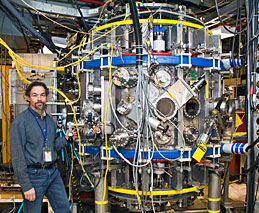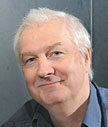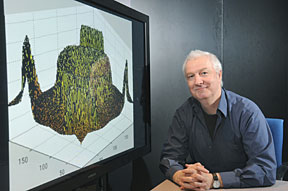Research
Highlights...
|
 |
Number 282 |
March 16, 2009 |
|
First plasma for LTX
 |
| Dick Majeski and the Lithium Tokamak Experiment (LTX) |
Researchers at DOE's Princeton Plasma Physics Laboratory recently produced the first plasma on the Lithium Tokamak Experiment (LTX). The new device studies pure lithium metal on surfaces facing or contacting the plasma. Plasma is a hot, gaseous state of matter used as the fuel to produce fusion energy —the power source of the sun and the stars; a tokamak is an experimental fusion machine. LTX may herald a new regime of plasma performance with improved stability, lower impurity levels, better particle and temperature control, and more efficient operation. "Even in a small machine like LTX, we expect a dramatic change in plasma parameters, and that's what we're quite excited about," said Bob Kaita. He and Dick Majeski (pictured with the experiment) are the LTX co-investigators. This improved performance may be possible because the LTX plasma is enclosed in a heated, conductive shell coated with molten lithium on the inside, and shaped to conform to the boundary of the plasma.
[Patti Wieser, 609.243.2757,
pwieser@pppl.gov] |
|
Paying less to tackle climate change
|
New scenarios chart emissions reductions needed to meet 2095 targets. |
A new set of climate scenarios reaffirms that a mix of advanced technologies could significantly reduce the cost to stabilize the global climate by 2095. Researchers from the Joint Global Change Research Institute, a collaboration between Pacific Northwest National Laboratory and the University of Maryland, used PNNL's MiniCAM model to simulate the economic, energy, climate and terrestrial systems under various conditions. For example, the model balanced the demand for biofuel against the need to retain cropland. The work offers a richer set of scenarios for understanding how technology could evolve, the uncertainties involved and the interactions between technologies for reducing greenhouse gas emissions. Details of the research funded by the multi-agency U.S. Climate Change Technology Program are available online.
[Kristin Manke, 509.372.6011,
kristin.manke@pnl.gov] |
|
Quantum dots could boost solar cell efficiency
Solar cells may soon be more efficient than previously thought possible, thanks to a recent result from the PULSE Institute for Ultrafast Energy Science, a joint institute of DOE's SLAC National Accelerator Center and Stanford University. The PULSE researchers confirmed the results of a Los Alamos National Laboratory experiment that measured one photon of light generating more than one electron of electricity in a so-called "quantum dot"—a sphere made of only a few thousand atoms. Scientists previously assumed that one photon could excite exactly one electron, limiting the efficiency of solar cells. Using a slightly different experimental method than previous such experiments, the PULSE researchers confirmed the Los Alamos findings and determined that a single photon can excite as many as three electrons in a quantum dot. The next step in the quest for efficient solar power is to build a solar cell that uses quantum dots to realize this efficiency.
[Melinda Lee, 650-926-8547,
mtlee@slac.stanford.edu] |
Tracking cropland CO2
For the first time, farmers have data that track at the county level carbon dioxide emissions associated with growing crops in the United States. This information is vital for examining changes in cropland production and management techniques and could play an even bigger role as more land is devoted to bioenergy crops, say researchers at DOE's Oak Ridge National Laboratory. By looking at changes in energy consumption and CO2 emissions that take place with conventional and alternative crop production, planners can do a better job of measuring the effects of various carbon sequestration strategies. The information can also contribute to future policy directions for energy use and agricultural production."
[Ron Walli, 865.576.0226,
wallira@ornl.gov] |
Turning algae into oil
DOE's Idaho National Laboratory has teamed with OriginOil, Inc., to make oil from algae. "Algae is the fastest growing biomass that we know of," said OriginOil Chief Technical Officer Vikram Pattarkine. Algae — a photosynthesizing organism more primitive than plants — requires only light, carbon dioxide and limited nutrients to grow. Making biofuel from algae requires large quantities of algae and the means to process fat-soluble molecules inside cells, called lipids, to remove oils. The initial phase of the project will focus on developing an energy balance model for systems that grow algae in a "photobioreactor." INL will analyze OriginOil's technology, devise models for reducing costs and meeting some of the system's commercial requirements.
[Keith Arterburn, 208/526-4845,
keith.arterburn@inl.gov] |
|
|
ANL researcher models
seizure-prone brains
|
Mark Hereld and a model of seizure-prone brains
|
A brain scan of a person experiencing an epileptic seizure looks like the Great Plains during an early evening in midsummer. Fierce electrical storms pop up seemingly at random, proliferate over large areas and subside almost as quickly as they arose.
The complex interplay of microscopic physical and biological effects that govern the strange dynamics of epileptic seizures has long remained a mystery to scientists and doctors who seek to comprehend and treat this common and often life-threatening condition.
In order to enrich their understanding of why seizures occur and propagate, scientists at DOE's Argonne National Laboratory have created a life-like model of small areas in the brain using state-of-the-art high-performance computers. The conclusions that Argonne researchers draw from these models directly impact their collaborations with clinical and laboratory neuroscience researchers at the University of Chicago.
For many years, computer scientists have used complex models known as "neural networks" to model brain activity. These simulations use many separate data structures to represent individual brain cells, or neurons. Because each neuron can receive information—in the form of an electrical pulse—from thousands to tens of thousands of other neurons, scientists need an extremely powerful computer to handle all of the model's interconnections, said Argonne computer scientist Mark Hereld. But, he added, the brain's complexity prevents any current model from accurately representing more than small sections of it.
Older neural networks treated each neuron as a fixed entity that could exist only in one of two states: firing or inactive. The more sophisticated models devised by Hereld and his colleagues treat each neuron as a pathway unto itself; they trace the route of an electrical signal from the fibrous dendrites into the cell body and out through the axon to other neurons. Rather than conceiving of each neuron as a single entity, Hereld's model treats it as a data chain, where each link represents a different physical site on the cell.
Hereld's model also offers another advantage over older neural networks. The "neurons" in the network are classified into one of six different groups, depending on their actual neurophysical role. The model also sorts the "wiring" of axons and dendrites that connects the cell bodies of different neurons into 32 separate types, each with different electrical and chemical properties.
According to Hereld, models of neural networks provide a glimpse into epilepsy that complements information obtainable through clinical or laboratory studies. "There are some questions that simply can't be answered by examining a live patient or looking at a small piece of brain tissue in the lab," Hereld said. "Computing offers the possibility of changing any parameter to answer highly targeted questions about the fundamental causes of seizures."
Submitted by DOE's Argonne National Laboratory
|
|





